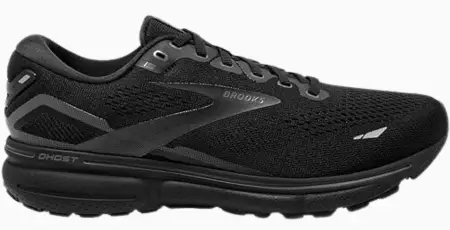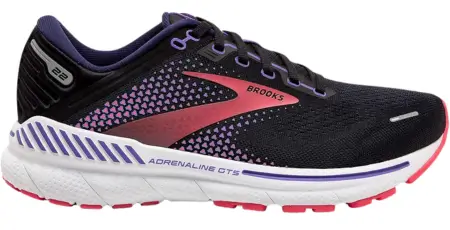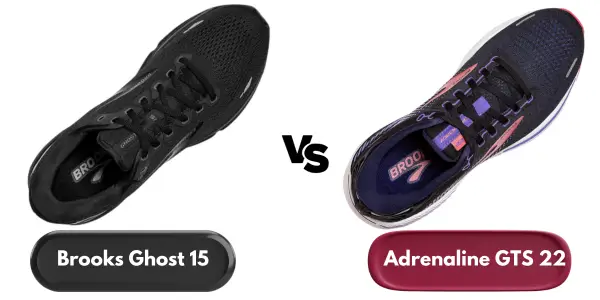Brooks Ghost vs Brooks Adrenaline
Last Updated: January 01, 2025 | Author: Jake Thompson
As a meticulous marathoner mulling over my next major shoe purchase, I've been caught in the crossfire between the Brooks Ghost 15 and the Adrenaline GTS 22.
I've logged countless kilometers in both models, each boasting its own heralded heritage in the running community, and my feet have become the ultimate testing ground.
The Ghost 15 offers an ethereal experience with its soft cushioning, tempting those who covet comfort over long distances, while the Adrenaline GTS 22 provides a promise of pronounced support, catering to runners needing a firmer grip on the ground.

But it's not just about the underfoot feel; myriad factors come into play, from the responsiveness of the midsole to the snugness of the fit.
As I tie the laces of these contenders and step onto the pavement, a lingering question remains: which pair will truly rise to the occasion when the rubber meets the road?
Join me as I dissect the finer points of these two formidable foes, and perhaps together, we can uncover which shoe might claim the crown for your stride.
For those interested in exploring other options in the Brooks lineup, our comparison of Brooks Levitate vs. Adrenaline offers insights into how these models stack up against each other.
Table of Content:
- Key Takeaways
- Table: Brooks Ghost vs Adrenaline Running Shoes
- Shoe Design Comparison
- Cushioning and Comfort
- Stability and Support
- Upper Construction
- Breathability
- Durability
- Outsole
- Midsole
- Fit and Sizing
- Performance on the Run
- Final Recommendations
- Frequently Asked Questions
Key Takeaways
- - The Ghost 15 is designed for neutral runners, offering balanced and soft cushioning for a natural gait.
- - The Adrenaline GTS 22 is built for overpronators, providing stability through its GuideRail system and firmer grip.
- - Both models have plush cushioning for comfort on long runs, with energy return and durability.
- - The Adrenaline GTS 22 offers exceptional stability with its specialized features, while the Ghost 15 provides support without corrective features, making it versatile for neutral gait patterns.
Table: Brooks Ghost vs Adrenaline Running Shoes

|

|
|
|---|---|---|
| Feature | Brooks Ghost 15 | Brooks Adrenaline GTS 22 |
| Terrain | Road | Road |
| Pronation type | Neutral | Overpronation |
| Drop | 13 mm | 12 mm |
| Heel stack height | 35 mm | 36 mm |
| Forefoot stack height | 23 mm | 24 mm |
| Weight (men) | 286 g | 289 g/10.2 oz |
| Weight (women) | 9.1 oz / 258.0g | 255 g |
| Features | Vegan, carbon-neutral | Vegan |
| Sizing | True to size and suitable for wide feet | True to size |
| Release year | 2022 | 2021 |
| Outsole | Rubber | Rubber |
| Midsole | DNA Loft, Omega Flex Grooves | DNA Loft, Omega Flex Grooves, Guide Rails |
| Upper | Engineered mesh | Engineered mesh |
| Softness (1- 5) | 4 – Soft | 4 – Balanced |
| Bounce (1- 5) | 3 – Moderate | 4 – Moderate |
| Speed | Slow, moderate | Slow, moderate |
| Distance | 10k, mid, half marathon, long, marathon | 10k, mid, half marathon, long, marathon |
| Workout | Daily running | Daily running |
| Price |
Related: Saucony Ride vs Brooks Ghost
Brooks Ghost 15
Pros:- - Supreme Comfort: The DNA Loft Cushioning, a standout feature in the Brooks lineup, ensures a plush, responsive feel, making the Ghost 14's successor ideal for long, comfortable runs.
- - Neutral Support: Perfect for runners with a neutral gait, the Ghost 15, like the Ghost 14, offers balanced support without overcorrecting the stride, maintaining its reputation as a reliable workhorse.
- - Versatile Design: Available in various colors, catering to a wide range of style preferences and continuing the legacy of the Brooks Ghost 14 vs other shoes in the lineup.
- - Flexibility: Offers a smooth ride with its flexible design, suitable for daily easy runs and a variety of training routines, making it a go-to choice for those who prefer a neutral running experience.
- - Breathability: The engineered mesh upper ensures your feet stay cool and comfortable throughout your run, whether on wet or dry surfaces.
Cons:
- - Limited Stability Features: This may not be the best option for runners who require extra support for overpronation, unlike its counterpart in the Brooks lineup, the Adrenaline GTS 22, which is a stability shoe.
- - Heavier Feel: Some runners might find it slightly heavier compared to other neutral running shoes, a factor to consider for those accustomed to shoes designed for speed.
- - Design: While functional, the design may not appeal to runners looking for a more modern or sleek look, a consideration for those who find the perfect style important in their shoe selection.
Brooks Adrenaline GTS 22
Pros:- - Enhanced Stability: The GuideRails support system, one of the standout features of the Adrenaline shoes, offers targeted support, reducing excess movement and aligning your stride, making the GTS 22 a stability shoe ideal for those with plantar fasciitis or people with flat feet.
- - Versatile Traction: Equipped with enough grip for both road and trail running, making it a versatile choice for different terrains and suitable for both wet and dry conditions.
- - Ample Color Options: Available in a wide array of colors, providing a broad choice to match personal style, a testament to Brooks being one of the leaders in the shoe lineup.
- - Responsive Cushioning: Despite being a stability running shoe, it offers a cushioned ride, balancing comfort and support, designed to provide a smooth road running experience.
- - Durability: Known for its robust build, it’s a reliable choice for runners looking for a long-lasting shoe, continuing the legacy of old shoes like the Adrenaline GTS 20.
Cons:
- - Heavier Structure: The added stability features might contribute to a slightly heavier feel, which could be a drawback for speed-focused runners or those used to the lighter Ghost or Adrenaline models.
- - Less Flexibility: While stable, it might not offer the same level of flexibility as more neutral shoes like the Ghost 15, potentially affecting the ride's smoothness.
- - Warm Upper: The design of the upper might not be as breathable as some runners prefer, especially in hot conditions, a factor to consider for those who train in warmer climates.
Shoe Design Comparison
Analyzing the Ghost and Adrenaline GTS reveals that, despite their shared DNA Loft v2 cushioning and similar flex groove patterns, the two shoes diverge significantly in their design focus, with the Brooks Ghost favoring more neutral support and the Adrenaline GTS delivering enhanced stability through its GuideRail system.
The Brooks Ghost, as a neutral shoe, offers a balanced midsole that's primed for those with a natural gait, while the heel and cushion work in tandem to absorb impact without corrective features.
In contrast, the stability shoe, Adrenaline GTS, incorporates GuideRails that actively counter overpronation, aligning the foot to prevent excessive inward rolling. This targeted support system is especially beneficial for runners whose ankles tend to collapse inward, ensuring a secure and stable stride throughout their run.
Dive deeper into the Brooks family with our detailed comparison of Brooks Adrenaline vs Glycerin, enriching your understanding of the Brooks Adrenaline as featured in this article.
| Quantitative Measures | Brooks Ghost 15 | Brooks Adrenaline GTS 22 |
|---|---|---|
| Cushioning System | Brooks DNA Loft Cushioning | Brooks DNA Loft Cushioning with GuideRails support |
| Heel Drop | 12 mm | 12 mm |
| Weight | Women: 9.1 oz, Men: 10.1 oz | Women: 9 oz, Men: 10.2 oz |
| Cushion Level | Moderate | Moderate |
| Shoe Type | Neutral | Stability |
| Color Options | 8 | 20 |
| Width Options | Available in Wide | Available in Wide |
| Traction | Designed for roads | Good for both roads and trails |
| Support System | Suitable for runners without overpronation | GuideRails for added stability, ideal for overpronation |
| Flexibility | Flexible, suitable for daily easy runs | Flexible with a focus on stability |
| Design & Aesthetics | Traditional running shoe look | Traditional look with more color patterns |
Cushioning and Comfort
While the design elements of the Ghost and Adrenaline GTS cater to different types of runners, both models offer a plush cushioning system that's essential for comfort in the long run. The Ghost, with its balanced and soft feel, allows for a smooth transition from heel strike to forefoot, catering to those who favor a neutral shoe.
In contrast, the Adrenaline GTS features the updated DNA Loft v2 cushioning which provides a comfortable ride yet maintains a level of firmness that supports overpronation.
- - DNA Loft Cushioning: Offers a softer, luxurious feel underfoot in both models.
- - Comfortable Ride: Ensures a smooth experience from heel to toe.
- - Cushioning Technologies: Advanced materials provide energy return and durability.
- - Heel Strike and Forefoot: Cushioning is tailored for protection and responsiveness.
Analyzing both, it's clear that while they share cushioning technologies, the Adrenaline GTS emphasis on stability potentially offers a more supportive ride.
Related: Brooks Trace vs Ghost
Stability and Support
Considering the inherent differences in foot mechanics, the Adrenaline GTS GuideRail system offers an exceptional level of stability for runners who experience overpronation, contrasting with the Ghost, which provides adequate support without specialized features for correcting gait issues.
When comparing the two, it's evident that the Adrenaline GTS is designed with runners who need stability, offering extra stability to counteract the tendency to overpronate. Its GuideRail system is a testament to Brooks' commitment to holistic support, guiding the feet into proper alignment, which is crucial for pronation vs. adrenaline management.
On the other hand, the Ghost, while it doesn't specifically target overpronation, still contributes to stability and support with its balanced cushioning, making it a versatile choice for those with neutral gait patterns.
Upper Construction
Turning to the upper construction, I've noticed both the Brooks Adrenaline GTS and Ghost sport-engineered mesh uppers is used on the shoes in the brooks lineup, though their approach to breathability and fit reflects their distinct purposes.
The Ghost 15's upper seems to prioritize a plush, sock-like feel, likely enhancing air circulation for those long, uninterrupted runs.
In contrast, the Adrenaline GTS 22's upper, while still breathable, appears more structured, potentially offering a snugger fit that could benefit runners needing extra support around the midfoot and ankle.
Breathability
Regarding the upper construction, both the Ghost and Adrenaline GTS excel in breathability due to their engineered mesh designs, ensuring that each step is met with a refreshing flow of air to keep the feet cool and dry.
- - Engineered Mesh: Both models feature uppers crafted with this breathable material, enhancing airflow.
- - Upper Fit: The mesh conforms to the foot, providing both snugness and breathability.
- - Flex Grooves: These improve the upper's flexibility, aiding in ventilation as the foot moves.
- - Daily Trainer: As training shoes built for everyday use, the importance of a breathable upper can't be understated.
As a runner who values a cool and comfortable experience, I find that the Brooks Ghost and the Adrenaline GTS series stand out. The seamless upper construction in these Brooks running shoes doesn't just offer breathability and is designed to adapt to my foot's natural movements, thanks to the integrated flex grooves. This attention to detail ensures that whether I choose the plush Brooks Ghost or the supportive Brooks Adrenaline GTS for my daily trainer, my feet stay refreshed mile after mile.
Expand your knowledge on Brooks running shoes by reading our Brooks Ghost vs Revel comparison, providing a broader context for the Brooks shoe line comparison.
Durability
When comparing the outsoles of the Brooks Ghost and Adrenaline GTS, I've noticed that both are crafted to tackle high mileage, but their designs reflect their distinct purposes.
The Ghost 15's outsole offers a balanced blend of grip and flexibility, suggesting a focus on a smooth transition, while the Adrenaline's is slightly more robust, hinting at its stability-oriented build for overpronators.
Moving to the midsoles, the DNA Loft foam v2 in both models promises enduring cushioning, but I'm curious to see how this translates into real-world resilience after prolonged use.
Outsole
Examining the outsoles of the Ghost and Adrenaline GTS reveals a shared commitment to durability, yet the Adrenaline GTS 22's additional midfoot stiffness stands out as a key differentiator for runners seeking extra stability. Here's a breakdown of their outsole characteristics:
- - Both best running shoes employ blown rubber to balance grip and longevity.
- - The Ghost 15's outsole allows for a fluid transition, accommodating natural foot motion.
- - Adrenaline GTS 22 targets overpronators by limiting excess movement through its structured outsole.
- - Each outsole is designed to endure the rigors of regular running, with specific zones for wear resistance.
Through detailed comparison, it's clear that while both outsoles are built to last, the Adrenaline GTS 22 offers a more analytical approach to stability, making it a standout for runners who need it.
Midsole
As we shift focus from the robust outsoles to the midsoles of the Ghost 15 and Adrenaline GTS 22, it's evident that their respective cushioning technologies are engineered with durability that caters to varying runner demands. The DNA Loft v2 midsole offers a plush yet responsive ride, designed to maintain underfoot comfort without sacrificing longevity.
| Feature | Brooks Ghost 15 | Adrenaline GTS 22 |
|---|---|---|
| Cushioning | DNA Loft v2 Foam | DNA Loft v2 Foam with GuideRails |
| Stability | Neutral (less support) | Stability (GuideRail system) |
| Targeted Demographic | Neutral Gait Runners | Runners Who Overpronate |
Fit and Sizing

In comparing the Ghost 15 to the Adrenaline GTS 22 regarding fit and sizing, I've found that while both shoes are true to size, the latter's stability features might result in a snugger feel, particularly around the midfoot area. As a runner, understanding the nuances between running shoes in the Brooks range is crucial, and here's what I've learned:
- - The Brooks Ghost 15 caters to those seeking a relaxed, roomy fit, especially at the toe box.
- - Adrenaline GTS 22 is aimed at runners with flat feet needing structured support.
- - The main difference lies in the snugness due to the Adrenaline's GuideRails system.
- - Sizing up in the Adrenaline might be necessary if you have a wider foot or prefer extra space.
Choosing the right pair of running shoes is a balance between personal comfort and the functional support each model offers.
Related: Brooks Adrenaline vs Glycerin
Performance on the Run
Understanding the fit and sizing nuances between the Brooks Ghost 15 and Adrenaline GTS 22 has sharpened my insight into how these differences manifest in actual running performance.
On the run, the Brooks Ghost 15 serves as my go-to for a cushioned experience, with its neutral support catering to my biomechanical needs. The DNA Loft foam v2 underfoot offers a plush yet responsive ride, complemented by a comfortable stack height in the heel.
In contrast, the Adrenaline GTS 22 is the embodiment of control for runners who need stability and support. Its GuideRail system is a game-changer for my overpronation, ensuring each step is aligned and secure.
When dissecting Brooks running shoes, the Ghost vs Adrenaline debate boils down to your unique stride and support requirements.
Final Recommendations (Brooks Ghost vs Brooks Adrenaline)
When deciding between the Ghost 15 and the Adrenaline GTS 22, it's crucial to weigh the importance of a neutral platform against the necessity for enhanced stability in your running shoes.
Here's my analytical take:
- - Neutral vs. Stability: Choose the Ghost 15 for a neutral ride; go for the Adrenaline GTS 22 if you need stability.
- - Foot Mechanics: The Adrenaline's GuideRails, a feature that the GTS Stands for, are a go-to support for overpronators.
- - Training Needs: Both can handle marathon training, but stability is pivotal for some.
- - Runner Preference: Ultimately, it's about what feels right for your feet and running style.
In this comparison of the Brooks Ghost and Adrenaline models, I've dissected their strengths. My final recommendations are grounded in the fact that these are both popular running shoes, each with a distinct purpose. Choose wisely based on your unique needs.
For a broader perspective on running shoe options, our review of Brooks Ghost vs. Revel provides a comprehensive comparison.
Frequently Asked Questions
1. What's the Difference Between Adrenaline GTS and Ghost?
I'm comparing two shoes, noting one offers stability while the other provides a neutral ride. They differ in support systems and cater to distinct runner types based on their foot mechanics and preferences.
2. Are Brooks Ghost 15 Good for Long Distance?
I've found the Brooks Ghost 15 to be excellent for long-distance runs. Its cushioning keeps my feet comfortable mile after mile, and the neutral support works well for my running style.
Interested in how footwear choices can impact your activities? Our guide on offers valuable tips for selecting the right shoes for hard surfaces.
3. Are Brooks Ghost 15 Good for Standing All Day?
I've found the Brooks Ghost 15 to be great for standing all day. Its DNA Loft midsole delivers the cushioning I need, and the balanced support keeps my feet comfortable for hours.
4. What Are Brooks Adrenaline GTS 22 Used For?
I've found that the Brooks Adrenaline GTS 22 is designed for stability, perfect for runners needing extra support due to overpronation. They're also great for daily training across various terrains.
Share this:







